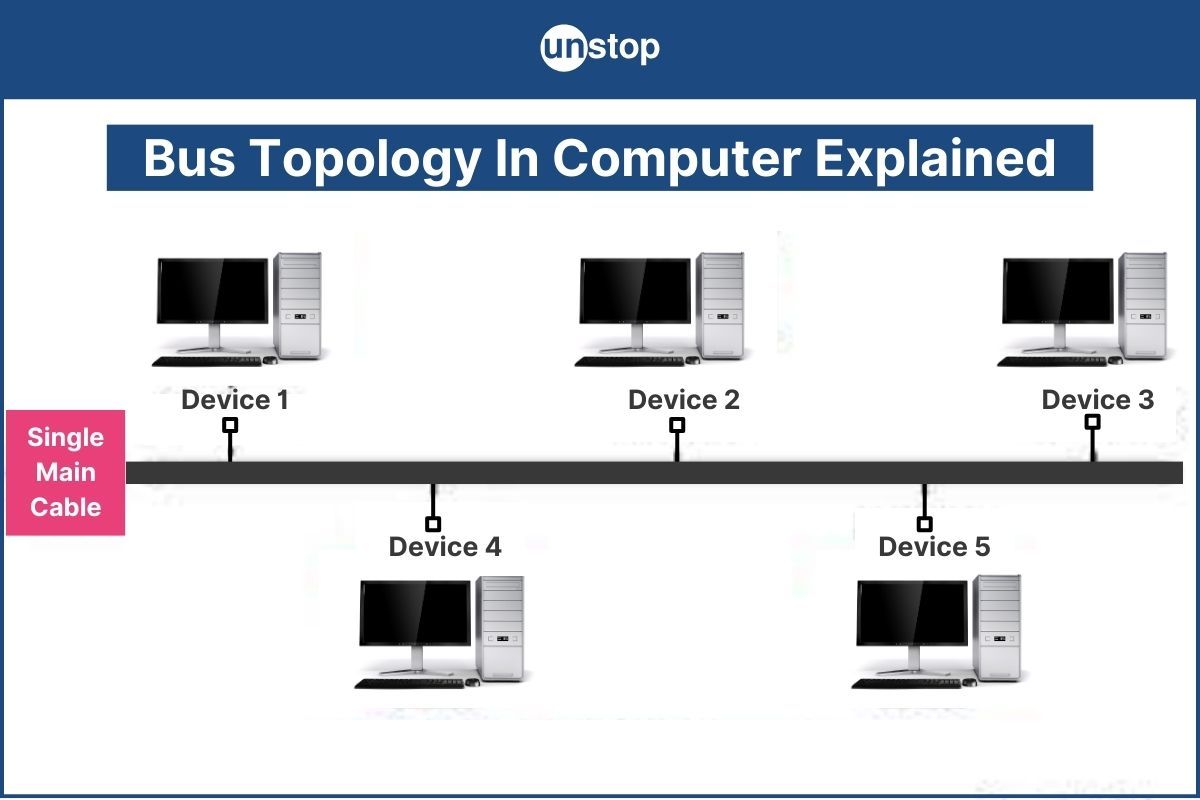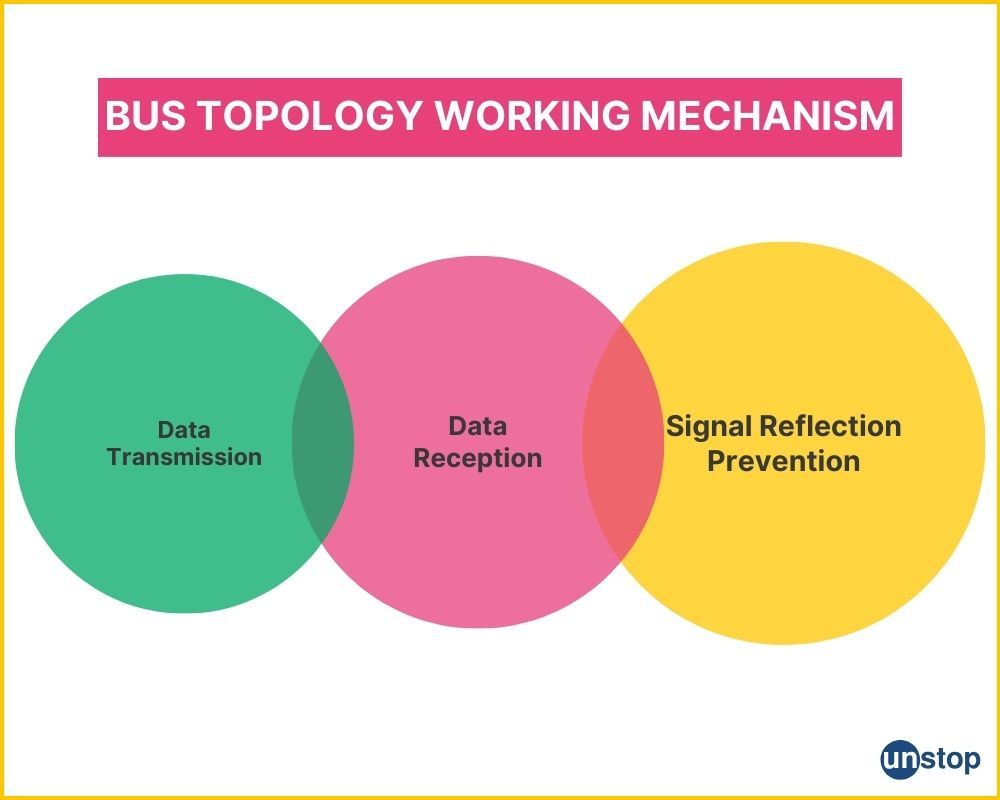- Understanding Bus Topology Basics
- Working Mechanism Of Bus Topology
- Advantages & Disadvantages Of Bus Topology
- Data Transmission In Bus Topology
- Cable Types For Bus Topology
- Bus Topology Vs. Other Network Topologies
- Common Applications Of Bus Topology
- Designing A Bus Topology Network
- Troubleshooting Bus Topology Issues
- Frequently Asked Questions (FAQs)
Bus Topology In Computer Network - Understand In Detail

The bus topology stands out as a fundamental structure among the network topologies of computers. Understanding how devices communicate on a shared communication line is critical to grasping the essence of this configuration. In this article, we will study the basics, working mechanisms, and types of bus topology.
Understanding Bus Topology Basics
Let's explore the ins and outs of bus topology to boost your understanding of the basics of computers. Mentioned below are some of the essential concepts of bus topology:
Single Cable Connection
Bus topology operates by connecting all devices through a single cable. This single communication line links all computers and network devices together. It is like a highway where data travels, with each device accessing the same path.
Devices in a bus network share the same communication channel. When one computer sends data, it travels along the cable, and every other device receives it simultaneously. This sharing mechanism simplifies communication within the network.
Suitable For Small Networks
Given its simplicity and cost-effectiveness, bus topology is commonly employed in small networks such as classrooms or office setups. Setting up this type of network requires minimal cabling and infrastructure, making it an ideal choice for limited spaces.
Working Mechanism Of Bus Topology
Let us study the working mechanisms of bus topology in computer networks:

Data Transmission & Reception
In a bus topology, data transmitted by one device is received by all others connected to the same network. This means that when a device sends information, all other devices on the network receive it simultaneously.
For example, if computer A sends a file to computer B in a bus network, computers C and D will also receive this data.
Devices in a bus topology setup can communicate directly with each other without the need for an intermediary device. This direct communication feature simplifies the network structure and enhances efficiency.
However, it's essential to note that since all devices share the same communication line, only one device can transmit data at any given time.
Signal Reflection Prevention
In bus networks, terminators are essential to avoid signal reflection problems caused by signals bouncing back and disrupting data transmission. Terminators are placed at each end of the main cable to prevent these issues.
These terminators absorb any signals reaching the end of the cable, ensuring smooth and uninterrupted communication across all connected devices on the bus network.
Advantages & Disadvantages Of Bus Topology
Understanding the advantages and disadvantages of bus topology is essential:
Easy Installation & Cost-Effective
Implementing a bus topology is straightforward, making it ideal for those new to networking. The setup involves connecting devices along a single cable, reducing complexity.

This simplicity translates into cost savings as it requires fewer cables and hardware components.
Stable Working With Limited Nodes
A bus network works well in environments with few connected devices, like small offices or home networks. The network's performance remains stable with limited nodes since data travels directly along the main cable without encountering many stops or delays.
Performance Drawbacks
However, the efficiency of bus topology can diminish as more devices are added to the bus network. Collisions occur when multiple machines attempt to transmit data simultaneously on the same line. These collisions lead to retransmissions and slower data transfer speeds overall.
Data Transmission In Bus Topology
Let us study how data transmission in bus topology works:
How Data Travels
Data transmission in bus topology involves data travelling in both directions on the main cable. Each device connected to the bus can send and receive signals through a single communication channel.
This broadcast communication method allows for efficient data sharing within the network. Devices listen for data addressed to them while ignoring information intended for other devices.
By using unique addresses assigned to each device, data can be accurately directed to its intended recipient without interfering with others' communications.
Handling Collisions
However, one challenge of bus topology is that collisions can occur if multiple devices transmit simultaneously. This issue arises when two or more devices attempt to send data simultaneously, leading to signal interference and potential data loss.
Bus networks implement protocols like CSMA/CD (Carrier Sense Multiple Access with Collision Detection) to prevent collisions and ensure smooth communication flow.
Cable Types For Bus Topology
There are different types of cables in bus topology. Let us study some of the important cable types in bus topology:
Coaxial Cables
Coaxial cables are prevalent in bus topology setups due to their reliability and efficiency. Thick coaxial cables outperform thin ones in terms of data transmission capabilities.
For instance, thick coaxial cables have a larger diameter, which allows for better signal strength over longer distances.
Twisted Pair Cables
In some bus networks, twisted pair cables can also be employed as the main cable for connecting devices. These cables consist of insulated copper wires twisted together to reduce electromagnetic interference between adjacent pairs.
While less common than coaxial cables in bus topologies, twisted pair cables offer flexibility and cost-effectiveness.
Bus Topology Vs. Other Network Topologies
Let us compare bus topology with other network topologies of computers in detail:
Less Cabling
In bus topology, less cabling is needed compared to a star setup. The bus layout uses a single backbone cable, reducing the wiring required. This simplicity can make installation and maintenance more accessible and more cost-effective.
On the other hand, the star topology necessitates cables running from each device to a central hub or switch. This design requires more cabling as each connection must have its cable back to the main point.
Bus topology's reduced cabling can be advantageous for ease of installation and scalability.
Fault Isolation
In a ring setup, if one node fails or there is an issue with one network section, data can still flow in both directions around the ring through alternative pathways until reaching its destination.
On the contrary, in a bus network where all devices are connected along a single cable line, any breakage or malfunction at one point can disrupt communication across the entire system until resolved.
Common Applications Of Bus Topology
Let us also study the typical application of bus topology:
Small Networks
This network setup allows multiple devices to connect along a single communication line, making it cost-effective for smaller settings.
Bus topology in small-scale environments like homes or offices provides a simple way to interconnect computers and devices without complex cabling structures. It's ideal when the number of connected devices is limited and does not require high bandwidth.
Industrial Control Systems
Due to its simplicity and reliability, industrial control systems frequently utilize bus topology. Bus topology offers an efficient solution in scenarios where various industrial machines or sensors need to communicate with each other within a factory floor.
For example, in manufacturing plants where machinery must constantly exchange data, implementing bus topology simplifies the network architecture by connecting all devices along a single communication line.
This streamlined approach enhances communication efficiency in industrial settings.
Designing A Bus Topology Network
Let us study how best we can design a bus topology network effectively:
Layout Planning
Planning the layout carefully is crucial when setting up a bus topology network. Consider the placement of devices like computers or nodes along the main cable. Ensure that each device is appropriately connected for smooth data transmission.
Proper spacing between devices is essential in a bus network. It helps prevent data collisions and ensures optimal performance. Maintaining adequate distance between stations can reduce network traffic congestion and enhance efficiency.
Terminator Usage
To prevent signal reflection issues in a bus network, terminators must be used at both ends of the main cable. These terminators absorb signals to avoid bounce-back effects that could disrupt communication across the network.
Troubleshooting Bus Topology Issues
Troubleshooting bus topology issues are essential. Let us see some of the ways of troubleshooting bus topology issues in detail:
Check Terminators
Check terminators for loose connections first. Ensure that each end of the main cable has a terminator securely attached. Loose terminators can cause signal reflections and disrupt network communication.
Confirm all terminations are in order to prevent data loss or corruption.
Verify That All Devices Are Connected Properly
It is important to ensure that all devices are properly connected to the main cable in a bus topology network. Any disconnected device can break the communication flow, leading to network downtime or slow performance.
Double-check each connection point to guarantee seamless data transmission.
Use Network Diagnostic Tools
Utilize network diagnostic tools when troubleshooting bus topology issues. These tools help identify signal disruptions quickly, allowing you to pinpoint where the problem lies within the network layout.
By using diagnostic software or hardware, you can efficiently troubleshoot connectivity problems and ensure optimal network performance.
Conclusion
Understanding bus topology's basics, mechanisms, advantages, and disadvantages is crucial for designing efficient network systems. From data transmission methods to cable types and troubleshooting techniques, a comprehensive grasp of bus topology ensures seamless operations.
Comparing it with other network topologies highlights its unique features and applications across various industries.
Frequently Asked Questions (FAQs)
1. What is Bus Topology?
Bus topology is a network layout where all devices are connected to a single communication line called the bus. It transmits data in both directions but one at a time.
2. How does Data Transmission work in Bus Topology?
In bus topology, data transmission occurs when a device sends signals onto the central bus. All devices receive these signals, but only the intended recipient processes them.
3. What are some advantages of Bus Topology?
Advantages of bus topology include simple design, cost-effectiveness due to minimal cabling, and easy installation and scalability for small networks.
4. What are some disadvantages of Bus Topology?
Disadvantages of bus topology involve potential network congestion with heavy traffic, limited cable length affecting more extensive networks, and difficulties in identifying faults or issues.
5. How does troubleshooting work in Bus Topology Networks?
Troubleshooting in bus topology involves:
- Checking for faulty connections or terminators.
- Examining signal interference points along the bus line.
- Using network monitoring tools to identify issues efficiently.
Suggested reads:
- Future Of Job Report 2023: AI & Machine Learning Trends For The Next 5 Years
- Learn How ChatGPT For Machine Learning Works: A Beginner's Guide
- Understanding Cloud Computing Architecture
- What Is Cache Memory In Computer? Understand the Basics
- What is Flow Control in Computer Networks? Understand In Detail
Instinctively, I fall for nature, music, humor, reading, writing, listening, traveling, observing, learning, unlearning, friendship, exercise, etc., all these from the cradle to the grave- that's ME! It's my irrefutable belief in the uniqueness of all. I'll vehemently defend your right to be your best while I expect the same from you!
Login to continue reading
And access exclusive content, personalized recommendations, and career-boosting opportunities.
Subscribe
to our newsletter
















Comments
Add comment